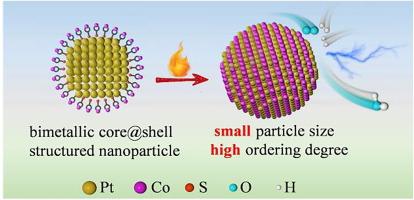利用双金属核@壳结构纳米颗粒合成金属间铂钴燃料电池催化剂
IF 13.1
1区 化学
Q1 Energy
引用次数: 0
摘要
金属间铂钴纳米催化剂对氧还原反应具有高活性和稳定性,因此是质子交换膜燃料电池(PEMFC)中低铂阴极催化剂的最佳候选材料。然而,形成金属间结构通常需要高温退火,这对实现良好的尺寸控制和高度有序的结构提出了挑战。在此,我们报告了双金属核@壳结构前驱体的设计与合成,以获得高性能的金属间铂钴催化剂。核@壳前驱体的制备包括使用一种同时含有硫和氧供体的分子配体,选择性地与作为核的铂胶体纳米粒子和作为壳的螯合钴离子结合。在高温退火过程中,配体会在合金纳米粒子周围形成碳涂层,从而防止粒子烧结;同时,外壳中的 Co 离子很容易扩散到铂核中,这有助于增加形成金属间结构的热力学驱动力。这些优点使我们能够获得分散度极小的纳米颗粒(∼3.5 nm)和高有序度(72%)的催化剂。该催化剂的阴极负载量为 0.1 mgPt/cm2,在 PEMFC 中具有优异的性能和耐久性,显示出 0.56 A/mgPt 的初始质量活性、0.67 V(H2-空气)时 1.05 W/cm2 的初始功率密度以及加速耐久性测试后 0.8 A/cm2 时 26 mV 的电压损失。本文章由计算机程序翻译,如有差异,请以英文原文为准。

Synthesis of intermetallic PtCo fuel cell catalysts from bimetallic core@shell structured nanoparticles
The high activity and stability of intermetallic PtCo nanocatalysts toward oxygen reduction reaction make them a top candidate as low-Pt cathode catalysts in proton exchange membrane fuel cells (PEMFCs). However, forming intermetallic structures typically requires high-temperature annealing, posing a challenge for achieving well-size control and highly ordered structures. Here we report the design and synthesis of bimetallic core@shell structured precursors for affording high-performance intermetallic PtCo catalysts. The fabrication of the core@shell precursor involves using a molecular ligand containing both sulfur and oxygen donors to selectively bind with Pt colloidal nanoparticles as the core and chelate Co ions as the shell. During high-temperature annealing, the ligand transforms into carbon coatings around alloy nanoparticles, preventing particle sintering; meanwhile, Co ions in the shell can easily diffuse into the Pt core, which helps to increase the thermodynamic driving force for forming intermetallic structures. These benefits enable us to obtain the catalyst with finely dispersed nanoparticles (∼3.5 nm) and a high ordering degree of 72%. With 0.1 mgPt/cm2 cathode loading, the catalyst delivers superior performance and durability in PEMFCs, showing an initial mass activity of 0.56 A/mgPt, an initial power density of 1.05 W/cm2 at 0.67 V (H2-air), and a voltage loss of 26 mV at 0.8 A/cm2 after the accelerated durability test.
求助全文
通过发布文献求助,成功后即可免费获取论文全文。
去求助
来源期刊

Journal of Energy Chemistry
CHEMISTRY, APPLIED-CHEMISTRY, PHYSICAL
CiteScore
19.10
自引率
8.40%
发文量
3631
审稿时长
15 days
期刊介绍:
The Journal of Energy Chemistry, the official publication of Science Press and the Dalian Institute of Chemical Physics, Chinese Academy of Sciences, serves as a platform for reporting creative research and innovative applications in energy chemistry. It mainly reports on creative researches and innovative applications of chemical conversions of fossil energy, carbon dioxide, electrochemical energy and hydrogen energy, as well as the conversions of biomass and solar energy related with chemical issues to promote academic exchanges in the field of energy chemistry and to accelerate the exploration, research and development of energy science and technologies.
This journal focuses on original research papers covering various topics within energy chemistry worldwide, including:
Optimized utilization of fossil energy
Hydrogen energy
Conversion and storage of electrochemical energy
Capture, storage, and chemical conversion of carbon dioxide
Materials and nanotechnologies for energy conversion and storage
Chemistry in biomass conversion
Chemistry in the utilization of solar energy
 求助内容:
求助内容: 应助结果提醒方式:
应助结果提醒方式:


